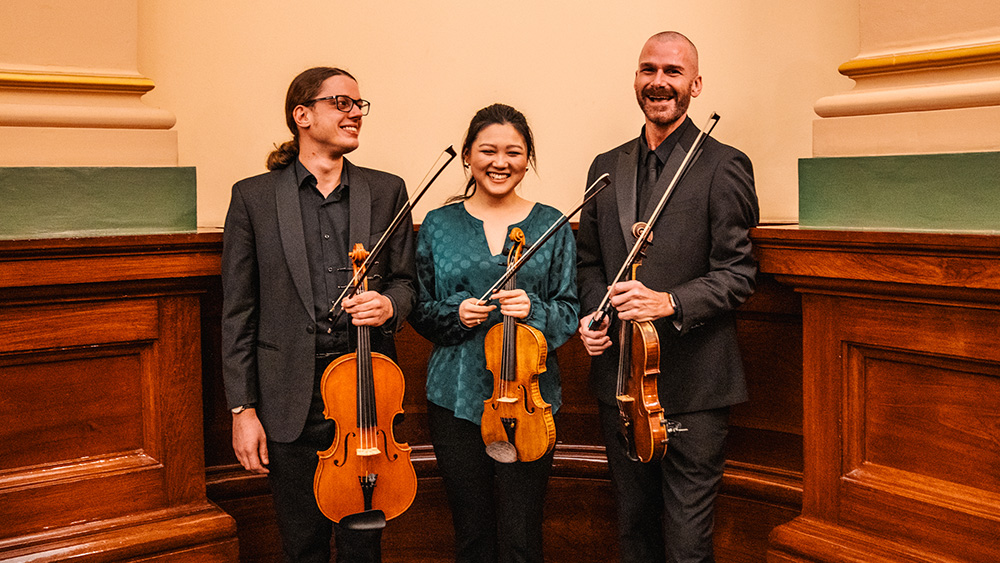Take a bow
- Behind the Scenes
- Subscriber Stories

An anonymous philanthropist has committed to acquiring and loaning bows of exceptional quality to professional musicians, elevating their performances and nurturing Australian talent. In conversation with both Principal Viola Justin Julian and the anonymous Patron, we explored the impact of this unique form of philanthropy.
What sort of bow are you currently using?
Justin: I’m very fortunate to be using a viola bow made in 1931 by the French bowmaker Eugène Sartory, who is widely regarded as the best bowmaker of the 20th Century. The bow is also significant as it was made for Maurice Vieux, an influential French viola pedagogue and Principal Viola of the Paris Opera for over 40 years.
How and when did you come to be offered the loan of a bow, and how has this made a difference to your playing?
I’ve known the Patron since 2018, and our shared love of music developed into a friendship over the years. My former teacher of six years, Roger Benedict, was borrowing the ‘ex-Vieux’ Sartory bow before me. When Roger heard I was hunting for a fine viola bow, he kindly returned the bow to the Patron, who then very generously agreed that I could borrow it. The Sartory combines unusual stiffness and sensitivity making it capable of unleashing incredible power and projection but also sophistication and delicacy. It is perfect for a principal violist who must play anything from the softest orchestral passages to difficult solos that must project over the rest of the orchestra.
How crucial is the quality of the bow to the overall sound production of a string instrument, and what can a good quality bow enable you to do?
A bow could be compared to the breath of a singer; while the instrument provides the core or ‘body’ of the sound, the bow has everything to do with how you shape it, from phrasing and articulation to colour and dynamics. A good quality bow enables you to play with extraordinary range and flexibility in all those areas, while also feeling very intuitive. Using a good bow feels like a natural extension of your body; you don’t have to think how you will make the kind of sound you’re looking for!
How difficult is it to select the perfect bow for a particular instrument?
Selecting the right bow is a difficult and highly subjective task, depending largely on the instrument and the player’s preferences for sound. I think of the bow as a perfect foil to the instrument – it should smooth over the weaknesses of your instrument and increase the versatility of sound. The ‘ex-Vieux’ Sartory is a great match with my 1979 Guiseppe Lucci viola because it adds richness and depth to a bright and clear sounding viola, creating a wide tonal range. The kind of philanthropy that provides musicians with good bows and instruments is so crucial as it allows them to find the right combination for their taste without incurring the six figure (or more) price attached to these decisions!
Comments from the Patron:
Why do you collect bows? Are they a good investment?
Fine bows can be a good financial investment if you buy well. Prices on the international market generally go up faster and more steadily than more common asset classes such as shares or property. But you only make a profit when you sell, which I don’t do. I just buy them and lend them to good players. For me, it pays off handsomely with what I call a “philanthropic dividend.” I get to hear musicians play on them, and many tell me they play better with the high-quality tools that I find for them. So the audience benefits too!
Do you collect instruments as well?
Yes, I have a few, mainly string instruments. I can’t afford Stradivari violins, but I can help over a hundred players for a fraction of the cost of one Strad. Australia has plenty of talented players who deserve better equipment than they can afford.
How can players get good instrument?
Even international stars don’t generally get paid enough to buy a Strad. A few very lucky ones have wealthy patrons who buy instruments as investments and lend them. Adelaide is blessed with Ulrike Klein’s extraordinary quartet of instruments by G.B. Guadagnini, who some experts rate alongside Stradivari. There’s also a Guadagnini violin currently on loan to Emily Sun. But there’s always more deserving talent than good instruments and bows to go around.
Are there many important patrons who prefer to be anonymous?
Yes. Some of the greatest violins in Australia are owned and lent by patrons who ask that they not be acknowledged, even though they are making an enormous contribution to the players’ careers and the enjoyment of the public. It’s comparable to making a donation, except that the violin remains the property of the lender. When Russell Crowe sold the violin he used in Master and Commander, the new owners lent it to the same violinist as Russell did, and have remained anonymous.
How would an investor who wanted to buy and lend an instrument go about doing this?
I wouldn’t recommend walking into a music shop and asking to see their most expensive violin. Both the instrument and the bow must suit the player: it’s a very personal thing. I would suggest starting by talking with a player whose style you like about their instrument and bow. Orchestras or ensembles will happily organize such a meeting for donors. The process should be enjoyable, but not rushed. It’s not like buying a Mercedes Benz from a showroom after a quick test drive. It’s more like buying a home for someone else to live in.
